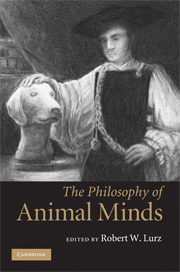Book contents
- Frontmatter
- Contents
- List of contributors
- Acknowledgments
- The philosophy of animal minds: an introduction
- 1 What do animals think?
- 2 Attributing mental representations to animals
- 3 Chrysippus' dog as a case study in non-linguistic cognition
- 4 Systematicity and intentional realism in honeybee navigation
- 5 Invertebrate concepts confront the generality constraint (and win)
- 6 A language of baboon thought?
- 7 Animal communication and neo-expressivism
- 8 Mindreading in the animal kingdom
- 9 The representational basis of brute metacognition: a proposal
- 10 Animals, consciousness, and I-thoughts
- 11 Self-awareness in animals
- 12 The sophistication of non-human emotion
- 13 Parsimony and models of animal minds
- 14 The primate mindreading controversy: a case study in simplicity and methodology in animal psychology
- Glossary of key terms
- References
- Index
14 - The primate mindreading controversy: a case study in simplicity and methodology in animal psychology
Published online by Cambridge University Press: 05 June 2012
- Frontmatter
- Contents
- List of contributors
- Acknowledgments
- The philosophy of animal minds: an introduction
- 1 What do animals think?
- 2 Attributing mental representations to animals
- 3 Chrysippus' dog as a case study in non-linguistic cognition
- 4 Systematicity and intentional realism in honeybee navigation
- 5 Invertebrate concepts confront the generality constraint (and win)
- 6 A language of baboon thought?
- 7 Animal communication and neo-expressivism
- 8 Mindreading in the animal kingdom
- 9 The representational basis of brute metacognition: a proposal
- 10 Animals, consciousness, and I-thoughts
- 11 Self-awareness in animals
- 12 The sophistication of non-human emotion
- 13 Parsimony and models of animal minds
- 14 The primate mindreading controversy: a case study in simplicity and methodology in animal psychology
- Glossary of key terms
- References
- Index
Summary
INTRODUCTION
What, if anything, do non-human primates (henceforth, “primates”) understand about the minds of other agents? Can they mentally represent and reason about the mental states of others? If they can, what kinds of mental states can they represent (e.g., perceptions, goals, intentions, beliefs) and what kinds of reasoning about mental states are they capable of? These are the central questions in the field of primate “mindreading,” or “theory of mind.” However, some thirty years after Premack and Woodruff (1978) posed such questions, there remains very little consensus on how we should answer them.
Much of the recent debate has centred on an ongoing controversy over whether primates are capable of reasoning about basic aspects of the visual perspective and perceptual awareness of others. Several researchers claim that recent behavioral experiments provide strong evidence for such a mindreading capacity in several primate species. Other prominent researchers, however, vigorously deny that these studies provide any evidence at all for mindreading.
One issue that has played a prominent role in this controversy and throughout the history of the debate over primate mindreading concerns the relative “simplicity” or “parsimony” (these terms are typically used interchangeably) of mindreading and non-mindreading explanations of behavior. In interpreting the available data, both proponents and skeptics about primate mindreading have argued that their chosen explanation is “simpler” or “more parsimonious” than the alternatives, and hence should be preferred.
Keywords
- Type
- Chapter
- Information
- The Philosophy of Animal Minds , pp. 258 - 277Publisher: Cambridge University PressPrint publication year: 2009
- 7
- Cited by

